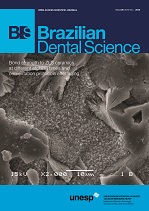Bond strength to ZLS ceramics at different etching times and cementation protocols after aging
DOI:
https://doi.org/10.14295/bds.2019.v22i4.1816Resumo
Objective: To assess the influence of 5% hydrofluoric acid etching time (ET), cementation protocol (CP), and thermal cycling (TC) aging on the microshear bond strength (µSBS) of zirconia-reinforced lithium silicate ceramic (ZLS) to adhesive resin cement. Material and Methods: Ten VITA Suprinity® ceramic blocks were cut in 120 slices (1.4 mm thickness) and randomly assigned to 12 groups (n = 10) according to the combination of factors (2x3x2 design): etching time (20 or 30 s), cementation protocol (silane + universal adhesive + resin cement; universal adhesive + resin cement; silane + resin cement) and thermal cycling (cycled or no-cycled). RelyX Ceramic Primer and Scotchbond™ Universal Adhesive were used respectively as silane (S) and universal adhesive (Ua). Ceramic surface was etched, and the cementation protocol performed on the delimited bonding area. Then, resin cement (RelyX™ Ultimate Cement [Rc]) cylinders were bonded and light cured. After, specimens were stored in deionized water at 37°C for 7 days and subjected to the µSBS test. Results: Data passed the normality test and three-way ANOVA analysis showed statistical difference (p<0.01) for isolated; double (ET/TC) (p<0.05), and triple (p<0.05) factor interactions. Conclusion: The combination 30s etching-Ua-Rc presented higher adhesive bond strength after thermal aging.
Downloads
Downloads
Arquivos adicionais
Publicado
Como Citar
Edição
Seção
Licença
TRANSFERÊNCIA DE DIREITOS AUTORAIS E DECLARAÇÃO DE RESPONSABILIDADE
Toda a propriedade de direitos autorais do artigo "____________________________________________________________________" é transferido do autor(es) para a CIÊNCIA ODONTOLÓGICA BRASILEIRA, no caso do trabalho ser publicado. O artigo não foi publicado em outro lugar e não foi submetido simultaneamente para publicação em outra revista.
Vimos por meio deste, atestar que trabalho é original e não apresenta dados manipulados, fraude ou plágio. Fizemos contribuição científica significativa para o estudo e estamos cientes dos dados apresentados e de acordo com a versão final do artigo. Assumimos total responsabilidade pelos aspectos éticos do estudo.
Este texto deve ser impresso e assinado por todos os autores. A versão digitalizada deverá ser apresentada como arquivo suplementar durante o processo de submissão.




























